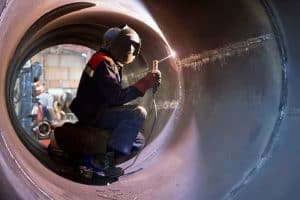To a normal person TIG and MIG are almost similar. They both use shielding gases, electric arcs, produce clean welds, and they use filler materials. But, a closer observation of the welds will reveal that the two methods are quite dissimilar.
If you ask a welder, you may not find conclusive results as each attests to the superiority of one. The truth it depends on the type of job you are engaging in. As we breakdown into the weld strength for each, you may want to have get a clear understanding of how the two welds operate.
TIG vs. MIG Operation
TIG and MIG welding are almost similar in that they both use electric current but operate differently. MIG stands for metal inert gas and the primary heat source is a consumable wire that unrolls itself from the welder. When electric current is passed through the wire it creates an arc that melts the metals to be joined. TIG stands for tungsten inert gas but unlike the MIG here you have a tungsten rod that at the tip melts the joints hence fusing them together. Both welding techniques use inert gases like argon, carbon dioxide or a mixture of both. In some instances you will have a mixture with helium. The essence of the inert gasses is to prevent the contamination of the joint from dirty air.
Here is the difference. With MIG welding you have heat moving all the way up from the weld joint to the base metal while with the TIG it is the reverse – heat moves from the base metal to the weld joint. This heat movement influences how the metal cools. Since in the MIG the base metal helps to dissipate heat, the joints made from MIG cool faster than those in a TIG joint. There is no sink effect in the TIG as the base metal is already hot. This cooling effect has an effect on the joint. With the MIG the heat will help make the metal hard but the fast cooling contributes to it becoming brittle. TIG slow cooling process helps produce more malleability and softer joints.
Arc creation

In the MIG a wire from the torch passes an electric current that forms the arc, in the TIG the tungsten rod is the one used for creating the arc. The MIG wire is consumable while the tungsten rod is not. This mode of operation affects the kind of arcs that are created. When it comes to the MIG the high heat produces a large arc that spreads through the surface, the TIG arc is narrower. The result is that in the TIG you have more penetration that the MIG.
Welds created by the TIG are more accurate and focus on a small point unlike the MIG that are spread over a larger surface area. The TIG produces a narrower flame that is hotter and that requires more heat. This makes it more efficient than the MIG.
Quality
Since the TIG welds are more penetrative they produce higher quality welds than the MIG. The MIG will leave behind small holes due to its large arc formation hence making it not suitable for wielding pressure vessels. While both MIG and TIG produce quality welds, the ones for the TIG are more refined, precise, clean and beautiful. This has helped them see use in various precision industries like aerospace, transportation, and the military. You can also use them with thinner gauge materials like stainless steel alloys. If you have some instrument like tool box or gunsmithing that requires precision then go with the TIG.
Welding speed
TIG produces a more high quality weld than the MIG however, this comes at the cost of it been a slower procedure. With the MIG weld you have can set up fast and have continuous welds without stopping. The downside with this speed is you compromise on penetration. It can be time-consuming changing a MIG welder from steel work settings to lets say aluminum. For one, you have to change your welder polarity, shielding gas, and perhaps the welding torch. However, with TIG all you need to do is switch your welder from DC to AC. Do to the fast heating nature of MIG, it is a fast process but when you are switching in between metals it can be slow.
Precision
The reason you have higher quality welds with the TIG is because you can control the speed of the gun. In TIG you use the tungsten rod – which non-consumable – to create an electric arc. You then can add filler to the joints. This flexibility allows one to control penetration of the weld and speed. In the MIG the filler and electrode are together. In some instances, a professional welder with use a foot pedal to control the heat levels. This works great when you are working on fine/thin metals. This level of penetration is more complicated than that with the MIG welder.
Cleanliness
One key benefit of using a TIG welder is it leaves a more cleaner surface due to better control of the filler. In fact, in most instances you do not need filler for TIG welding. Since the tungsten tip is a non-consumable you do not have to worry about lots of cleaning in between jobs. You also have less materials to use in TIG welding. While the welding done through MIG looks good, you can’t compare it with that of the TIG. This is because the TIG produces a tight and uniform pattern do to the lack of splatter.
How to improve the quality of your welds
 Having quality welds is as important as choosing the right welding technique. If you want the best results when welding then direct the wire to the weld pool leading edge. If you plan on doing some out-of-position welding i.e. horizontal, vertical or overhead welding then for the best results use a small weld pool. This also requires a small wire diameter for the best bead appearance. If you notice that you are producing very skinny and tall beads then the problem is lack of heat for the weld or you are using a fast travel speed. Alternatively, if you are having wide and flat bead then it is that your welding is too hot or you are welding too slowly. This means you need constant practice for getting the perfect weld.
Having quality welds is as important as choosing the right welding technique. If you want the best results when welding then direct the wire to the weld pool leading edge. If you plan on doing some out-of-position welding i.e. horizontal, vertical or overhead welding then for the best results use a small weld pool. This also requires a small wire diameter for the best bead appearance. If you notice that you are producing very skinny and tall beads then the problem is lack of heat for the weld or you are using a fast travel speed. Alternatively, if you are having wide and flat bead then it is that your welding is too hot or you are welding too slowly. This means you need constant practice for getting the perfect weld.
The filler should be stored in airtight containers as it often get damaged by moisture. Contact with moisture causes the weld to crack due to hydrogen. This also means you should wear gloves any time you are handling the wires. If you are not using your spool wire, then cover it with some plastic or lock it in a cabinet that is free from moisture.
MIG uses inert gases to protect the weld from atmospheric oxygen. Oxidation leads to the combination of oxygen with carbon to produce carbon monoxide. In flux core welding you have the flux containing elements that when heated produces the right shielding gases to protect your weld. In most fabrication shops the right inert mixture during MIG welding is 75% argon and 25% carbon dioxide. 100% carbon dioxide while offers better penetration it also produces more spatter than the MIG welding. The choice of the inert gasses will depend on the type of metal you are welding. For solid carbon steel you will need a carbon steel wire with carbon dioxide mixture of 75% and argon of 25%. Remember that with MIG welding you will be forced to do your welding indoors so that the inert gasses do not get blown by wind.
If you are welding aluminum then use an aluminum wire with more argon as the shielding gas. Stainless steel will work well with a tri-mix of argon, helium and carbon dioxide.
The contact tip plays an important role in the kind of weld that you get. Since the tip of the MIG is consumable the position of the contact tip influences porosity, spatter, and penetration. The right position is measured by the recess extension. A ¼ inch recess will need an amperage of less than 200 while a 1/8 inch recess extension requires a wire stick out of ½ to ¾ inch.
Lastly, welding is a technique that produces a lot of heat and spatter. This means you should have the right clothing before you can start welding. Wear gloves whenever you are operating the weld. Due to the high number of sparks in MIG welding it is imperative that you have protective clothing for your arms so as to reduce burns. Wear leather boots to protect your feet from accidents.
Conclusion
MIG welding is the simplest way to learn welding. It produces a cleaner weld with less spatter. But the TIG offers a narrower arc that gives you better penetration. This makes the TIG ideal for dealing with rusty metals. MIG uses inert gases like argon and carbon dioxide that is fed to the weld. This has the downside of limiting the use of MIG welding to indoors. TIG is ideal for outdoors as the flux core is the one that produces the shielding gas when it is heated.
